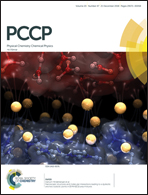Mechanism of phase transfer of uranyl ions: a vibrational sum frequency generation spectroscopy study on solvent extraction in nuclear reprocessing†
Abstract
Mechanistic understanding of solvent extraction of uranyl ions (UO22+) by tributyl phosphate (TBP) will help improve the technology for the treatment and disposal of spent nuclear fuels. So far, it has been believed that uranyl ions in the aqueous phase are adsorbed to a TBP-enriched organic/aqueous interface, form complexes with TBP at the interface, and are extracted into the organic phase. Here we show that uranyl–TBP complex formation does not take place at the interface using vibrational sum frequency generation (VSFG) spectroscopy and propose an alternative extraction mechanism that uranyl nitrate, UO2(NO3)2, passes through the interface and forms the uranyl–TBP complex, UO2(NO3)2(TBP)2, in the organic phase.



 Please wait while we load your content...
Please wait while we load your content...